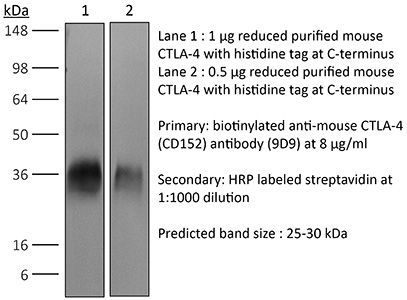
InVivoMAb anti-mouse CTLA-4 (CD152)
BE0164
ApplicationsWestern Blot, Neutralisation/Blocking, Other Application
Product group Antibodies
ReactivityMouse
Overview
- SupplierBio X Cell
- Product NameInVivoMAb anti-mouse CTLA-4 (CD152)
- Delivery Days Customer3
- ApplicationsWestern Blot, Neutralisation/Blocking, Other Application
- CertificationResearch Use Only
- ClonalityMonoclonal
- Clone ID9D9
- Concentration4-11 mg/ml
- HostMouse
- IsotypeIgG2b
- ReactivityMouse
- Storage Instruction2°C to 8°C
- UNSPSC12352203
References
- Induced PD-L1 expression mediates acquired resistance to agonistic anti-CD40 treatment. Zippelius A et al., 2015 Mar, Cancer Immunol ResRead more
- Curing mice with large tumors by locally delivering combinations of immunomodulatory antibodies. Dai M et al., 2015 Mar 1, Clin Cancer ResRead more
- Microtubule-depolymerizing agents used in antibody-drug conjugates induce antitumor immunity by stimulation of dendritic cells. Mueller P et al., 2014 Aug, Cancer Immunol ResRead more
- ER stress regulates myeloid-derived suppressor cell fate through TRAIL-R-mediated apoptosis. Condamine T et al., 2014 Jun, J Clin InvestRead more
- Combined targeting of costimulatory (OX40) and coinhibitory (CTLA-4) pathways elicits potent effector T cells capable of driving robust antitumor immunity. Redmond WL et al., 2014 Feb, Cancer Immunol ResRead more
- Combinatorial PD-1 blockade and CD137 activation has therapeutic efficacy in murine cancer models and synergizes with cisplatin. Wei H et al., 2013, PLoS OneRead more
- Activating Fc gamma receptors contribute to the antitumor activities of immunoregulatory receptor-targeting antibodies. Bulliard Y et al., 2013 Aug 26, J Exp MedRead more
- Long-lasting complete regression of established mouse tumors by counteracting Th2 inflammation. Dai M et al., 2013 May, J ImmunotherRead more
- Selective BRAF inhibition decreases tumor-resident lymphocyte frequencies in a mouse model of human melanoma. Hooijkaas A et al., 2012 Aug 1, OncoimmunologyRead more
- Imatinib potentiates antitumor T cell responses in gastrointestinal stromal tumor through the inhibition of Ido. Balachandran VP et al., 2011 Aug 28, Nat MedRead more




